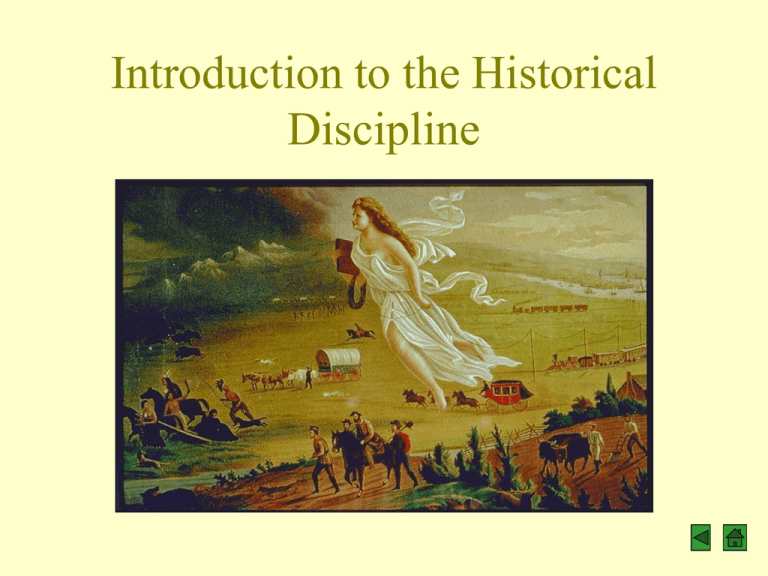Introduction to the Historical Discipline
advertisement

Introduction to the Historical Discipline This presentation introduces • The historical discipline, including the kinds of questions that historians ask • The variety of primary sources that historians use • How to analyze primary sources • How to use secondary sources Part One The Historical Discipline Why History? A People Without a History Are Like Wind in the Buffalo Grass (Lakota Indians) • Why is a people's memory of itself essential to its identity? • How is the absence of a people's collective memory like the wind in the buffalo grass? • What does this analogy tell us about the Lakota Indians? What Others Have Said •History is more or less bunk. (Henry Ford) •Those who cannot remember the past are condemned to repeat it. (Santayana) •History is a people's memory, and without memory man is demoted to the lower animals. (Malcolm X) •History is a science, no less and no more. (J.B. Bury) •History is an argument without end. (Peter Geyl) •No single man makes history. (Boris Pasternak) How is history different than other disciplines? Historians Want To Know • What? • Why? • How? • When? • Who? The Historian as Investigative Reporter • Study the data • Conduct interviews • Hear all points of view. The Basic Steps of Historical Analysis • Identify a historical problem or an interesting historical topic. • Find appropriate sources. • Analyze the sources by asking the right questions. • Create analytical narratives or histories about the past. The Big Questions Historians Ask: Social How did those originally excluded from the political process (the propertyless, women, AfricanAmericans, Latinos, Asians, gays & lesbians) win their way into the democratic system? The Big Questions Historians Ask: Political What explains the decline of new deal liberalism after 1964? The Big Questions Historians Ask: Economic What factors contributed to industrial development in the Northern states during the middle of the nineteenth century? The Big Questions Historians Ask: Cultural How have definitions of success changed over time? Part Two: Types of Sources • Primary Sources: sources written or created by the historical actors • Secondary Sources: findings of someone who did not observe the event, but who investigated primary sources other secondary accounts to retell the event Primary Sources Written Visual Oral Types of Written Primary Sources • • • • Memoirs Diaries Letters Government records • Newspapers Types of Visual Primary Sources • • • • • Paintings Cartoons Photographs Films Television Types of Oral Primary Sources • • • • • • • Stories and Narratives Oral histories Anecdotes Jokes Folk songs Radio recordings Popular music Part Three: Analyzing Primary Sources • Basic Questions to Ask All primary sources • The Time and Place Rule • The Bias Rule • Assessing the Quality of the Primary Source • Special Instructions for Visual Sources Questions to Ask All Primary Documents • Who created the document? • What is the nature of the document? • When was the document created? • Why was the document created? • What does the document mean? The Time and Place Rule Usually, the closer in time and place a source and its creator were to an event in the past, the better the source will be. Thus the best primary sources might include some of the following: • Direct traces of the event • Accounts of the event, created at the time it occurred, by firsthand observers and participants • Accounts of the event, created after the event occurred, by firsthand observers and participants • Accounts of the event, created after the event occurred, by people who did not participate or witness the event, but who used interviews or evidence from the time of the event. The Bias Rule • Every piece of evidence and every source must be read or viewed skeptically and critically. • No piece of evidence should be taken at face value. The creator's point of view must be considered. • Each piece of evidence and source must be crosschecked and compared with related sources and pieces of evidence. Assessing the Quality of the Primary Source • Who created the source and why? • Did the recorder have firsthand knowledge of the event? • Was the recorder a neutral party? • Was the source meant to be public or private? • Did the recorder wish to inform or persuade others? • Was the information recorded during the event, immediately after the event, or after some lapse of time? Special Suggestions for Visual Sources • Look for internal clues to determine when the visual source was created • Look at the internal evidence by dividing the illustration into parts: background and foreground, individuals, objects, or quadrants Part Four: How to Use Secondary Sources Types of Secondary Sources • Textbooks • Monographs (published books on specific topics) • Statistical tables • Graphs • Pictures and drawings • Historical novels, short stories, movies Ways to Use Secondary Sources • As a collection of facts • As a source of background material for a specific time, a specific place, or a specific concept • As an interpretation to stimulate your thinking Questions To Ask Secondary Sources • What is the author's thesis? • Is the thesis relevant to my research? • How can I determine the accuracy of the secondary source? How To Evaluate a Secondary Source • Currency • Authority • Scholarship Questions to Consider When Assessing a Secondary Source • What is the author’s evidence? • Does the evidence support the author’s thesis? • What are the author’s biases? How much do these biases influence the author’s interpretation? Special Questions for Internet Sources • Who published this document? • What credentials does the author claim to have? • What is the author’s objective in producing the document? • How current is the site? • Do traditional sources of information substantiate information found in an Internet-based source? Special Questions for Journal Articles • When was the article published? • Who publishes the journal? • What type of paper is it? – Opinion paper? – Empirical study? – Literature review? • What is the nature of the supporting evidence • Is there a bibliography? • The End







